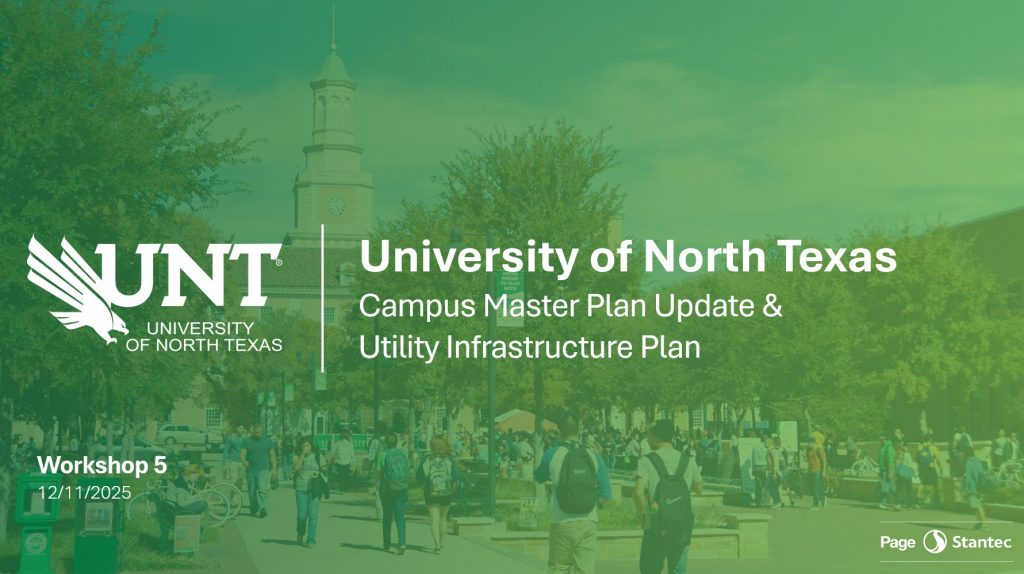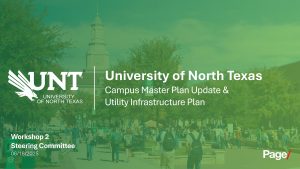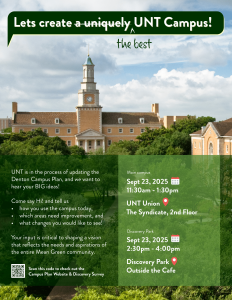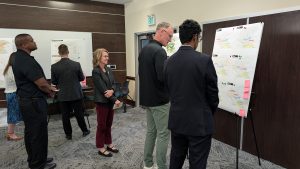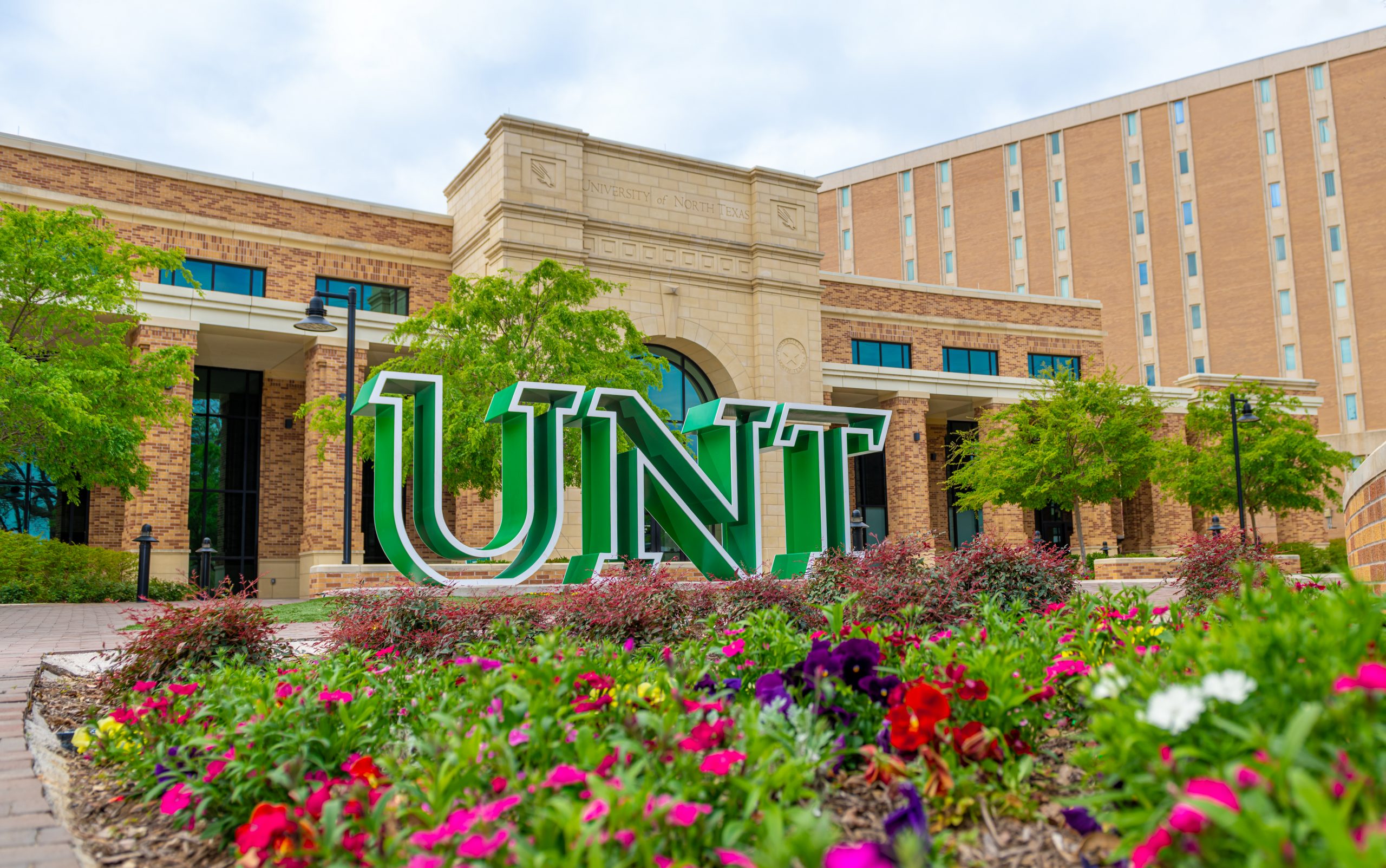
About the Plan / Q&A
The UNT Campus Master Plan is rooted in collaboration, shaped through campus-wide engagement, and aligned with the university’s emerging 2025 Strategic Plan. This process will ensure that future campus investments reflect the values, priorities, and bold vision of the Mean Green community. Below are commonly asked questions:
×
A campus master plan is a long-term planning framework that guides the physical development of a university’s campus to support its academic mission, student experience, and community impact. It provides a vision for how buildings, open spaces, mobility networks, and utility infrastructure should evolve over time. More than just a map or list of projects, a campus master plan is about aligning PURPOSE (strategic institutional goals), PEOPLE (students, faculty, staff, and the community), and PLACE (the physical campus environment) to create a more connected, welcoming, and forward-thinking campus. The plan helps ensure that future growth is intentional, resilient, and reflects the values and aspirations of the university.
×
Yes! UNT has a rich history of campus planning. Over its century plus existence numerous plans have been periodically completed. Each has helped to shape the campus we enjoy today. The last three completed efforts were in 1998, 2005, and 2013. In fact, the State of Texas actually recommends that public universities like UNT update their campus master plans roughly every decade to support long-term capital planning and stewardship. Since the last campus-wide plan, UNT has also advanced several more focused efforts, including master plans for Athletics, the College of Music, Parking and Transportation, Housing, and the UNT Frisco campus. These recent unit- and system-level plans will help inform the current planning effort.
To explore recent campus master planning efforts across the UNT System, please visit our planning website.
Older historic campus master plans are also available through the UNT library archives.
×
The campus master plan shapes the future of the places where you study, work, teach, live, and connect. Whether you’re navigating campus pathways, using academic buildings, attending events, or relaxing in open spaces, the master plan influences your daily experience and long-term opportunities. This is your chance to help imagine what UNT should look and feel like in the years ahead—ensuring the campus grows in ways that reflect the values, needs, and aspirations of the entire Mean Green community.
×
While a campus master plan is a long-term roadmap, its influence begins right away by guiding priorities and future investment. It helps determine how UNT should grow—where new buildings might go, how we move around campus, how to enhance green space and outdoor areas, and what infrastructure needs improvement. It also supports planning around housing, resiliency, and accessibility. Some projects may take a decade or longer to implement, but other recommendations may be implemented as quickly as months after plan completion. The plan will serve as a foundation for decisions starting now and for years to come.
×
The final campus master plan will be a comprehensive, illustrated guide to the future of the UNT campus. It will include big-picture strategies, specific ideas for future development, and visual concepts that show how the campus could evolve over time.
Each final plan deliverable is unique, reflecting the brand, identity, and needs of the campus. Most frequently, final campus master plans take the form of a graphic report. The final report will be shared with the public and made available online so everyone can see and understand the path forward.
To see recent examples of campus master plan reports across the UNT System, please visit their website.
×
A small Executive Committee—led by President Keller—will be responsible for making final decisions on the campus master plan. They will be advised by a larger Steering Committee that brings together voices from across campus, including student representation, to ensure a wide range of perspectives are reflected in the process. Both groups will be informed by broader engagement with the UNT community in the form of surveys, open houses, focus groups, and other engagement platforms ensuring that the plan reflects shared priorities and builds on ideas gathered through listening and collaboration.
Our Process
The UNT Campus Master Plan is an 18-month effort organized into three distinct but connected phases: Discovery, Ideation, and Synthesis. Each phase builds on the last, combining technical analysis with community input to shape a long-term vision for the campus. The final plan will be delivered in August 2026 and presented to the UNT System Board of Regents in November 2026.
In this first phase, the planning team works to understand the current state of UNT—its buildings, infrastructure, goals, and community needs. This includes reviewing previous plans, touring the campus, collecting data, and aligning with UNT’s strategic priorities. Most importantly, this phase lays the groundwork for meaningful engagement with students, faculty, staff, and stakeholders to ensure the process reflects the UNT community.
In the Ideation phase, we explore different possibilities for how the campus could evolve. Using what we learned in Phase 1, the team will test ideas, develop early concepts, and work with the UNT community to refine them. Through collaboration and feedback, this phase moves us toward a shared vision and preferred direction for future development.
The final phase brings everything together into a coordinated and actionable plan. The team will finalize strategies for campus development, utilities, and facility improvements—all aligned to support UNT’s long-term success. The result will be a comprehensive set of plans, including implementation steps, design guidance, and visual materials to help bring the vision to life.
Events & Resources
Upcoming Events:
Previous Events:
Share your Ideas!
We are excited to hear your ideas for the future of UNT's campus! There will be many opportunities for the broader campus community to engage with the planning team before project competition. We look forward to meeting you at these events. Beyond these opportunities, if you have any general questions or comments, please use the form below to engage with our team.

